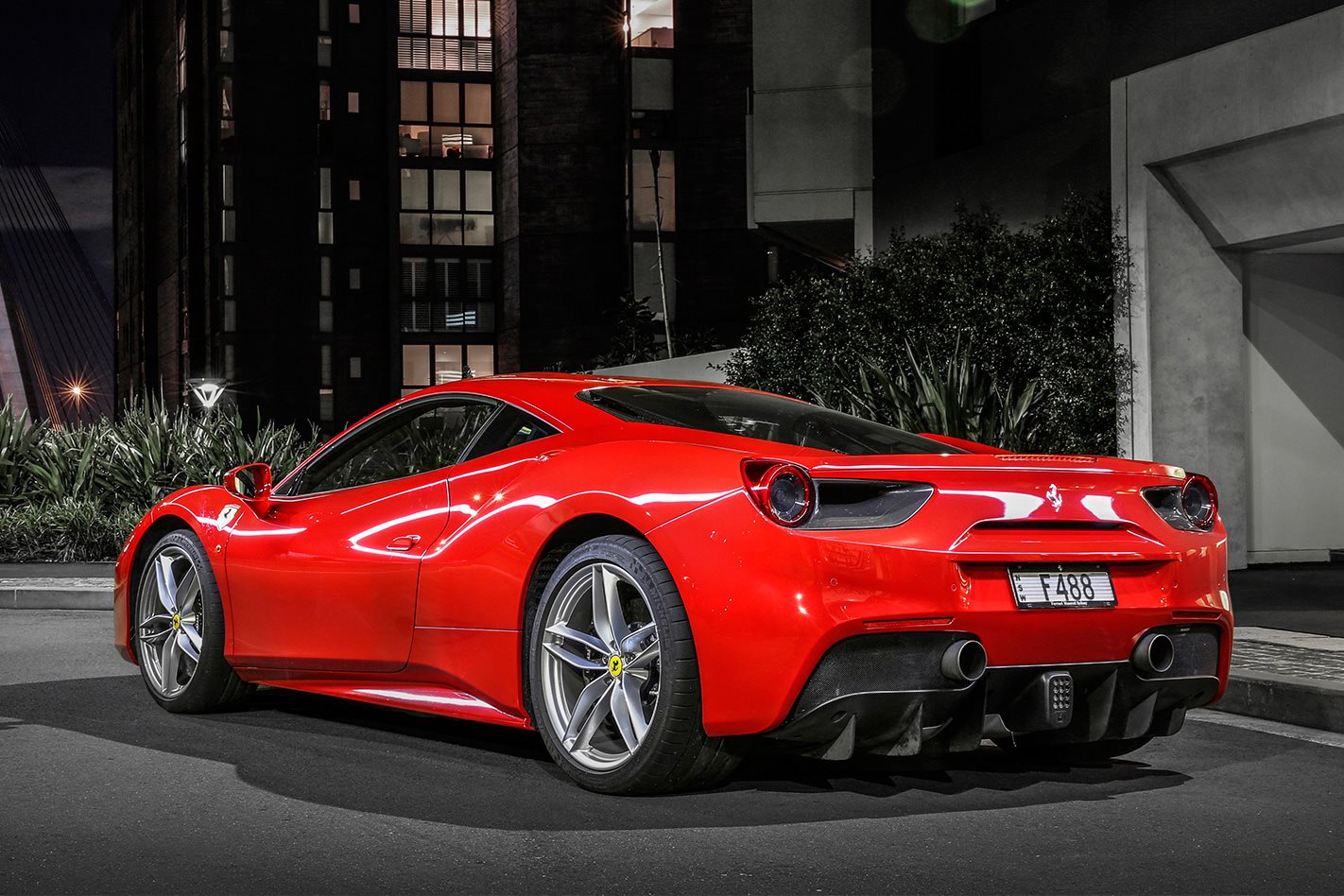Its rate of acceleration is simply phenomenal, quite simply in a class of its own… yes, the Ferrari really is the boss.”
These words appeared in MOTOR’s October 2004 issue and the Ferrari in question was the incredible Enzo, which had just annihilated its supercar opposition in a group test at Italy’s famous Nardo speed bowl.
Equipped with a bellowing 485kW/650Nm 6.0-litre V12, the Enzo blew past 100km/h in 3.6sec, dispatched the quarter in 11.4sec at 212.5km/h and flew to a 352km/h top speed. Its nearest rivals, Porsche’s Carrera GT and the Mercedes-Benz SLR McLaren, trailed by 21km/h. In a pre-Veyron world it was the undisputed king.
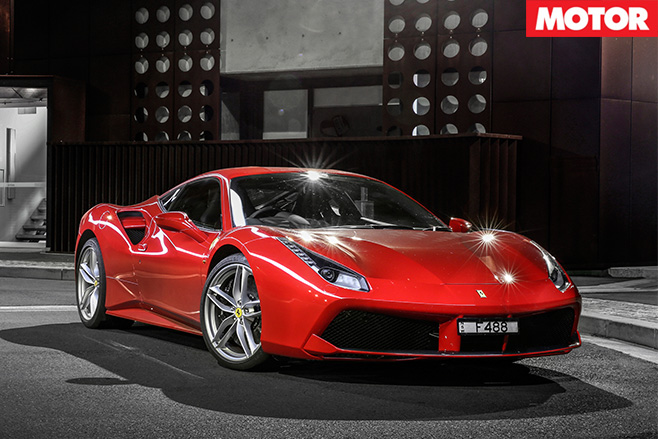
Thanks to two turbochargers and a decade’s worth of engine development, the 488’s 3.9-litre V8 bests the Enzo’s V12 with 492kW/760Nm. At 1475kg it carries an extra 110kg, yet Ferrari claims the 488 will hit 100km/h from rest in 3.0sec and cover the standing quarter in a mind-warping 10.45sec. But the truly jaw-dropping stat is the 488’s 0-200km/h time of 8.3sec. Eight-point-three!
To put that in context, having not sampled any of the current crop of hypercars, my current acceleration benchmark is the latest Porsche 911 Turbo, a car that feels like it compresses time and space, yet trails the Ferrari by a full 2.0sec to 200km/h.
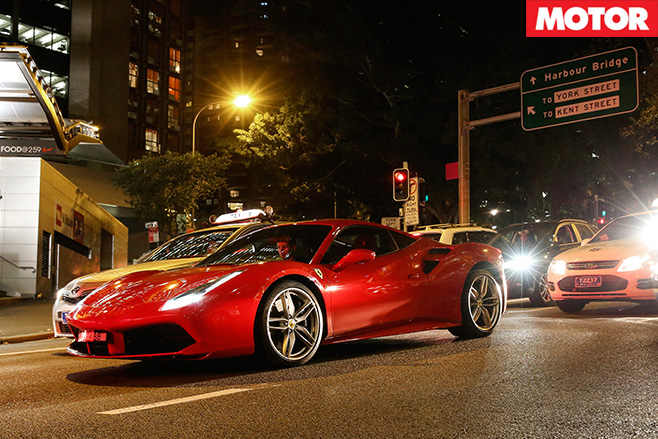
Frustratingly, the answer must wait, as Sydney’s suburban streets aren’t designed to exploit firepower of this magnitude. Even so, there are early hints as to its potency, the rear tyres chattering in response to a quick stab of throttle in second.
Driving a half-million-dollar supercar through city traffic might sound like a recipe for sweaty palms, but the 488’s comfort and useability lowers its intimidation factor markedly.
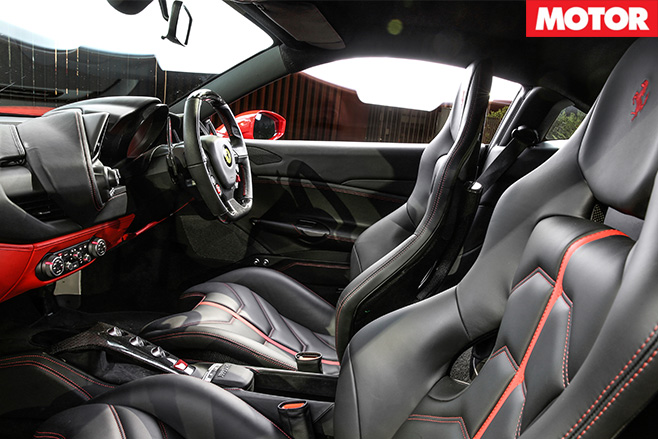
With all major controls moved to the steering wheel some acclimatisation is necessary but within a day, operating the lights, wipers and indicators becomes second nature.
The rest of the interior is a similar story. Two digital screens flank the enormous central tachometer, the left displaying all manner of vehicle information (turbo boost, tyre temperature, trip information, etc) and the right responsible for media, telephone and sat-nav.
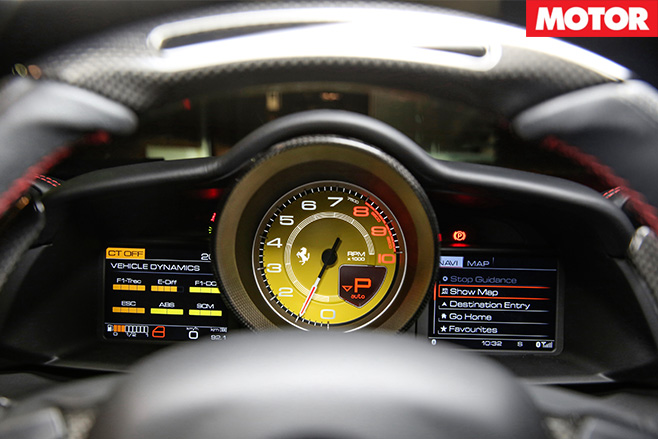
The driving environment is similar to the 458’s; no surprise as, despite its vastly different mechanicals, the 488 is still essentially a mid-life update of its predecessor – the next all-new mid-engined Ferrari isn’t due until 2021.
Plenty of wheel and seat adjustment makes the weirdo long-arm, short-leg ‘Italianised’ driving position a thing of the past, though the $15,000 carbonfibre racing seats are very firm. Numb bum will set in later, but as the 488 and I escape Sydney’s northern fringes I realise I could – and would – use this Ferrari every day.

Press the picture of a shock absorber on the steering wheel and the whole car… relaxes. It doesn’t morph into a Rolls-Royce Phantom, but most impacts are now smothered, like being punched through a pillow. Bumpy Road soon becomes part of the start-up procedure.
Turning off the Pacific Motorway at Calga, the first opportunities to taste the 488’s performance present themselves. To ease into it, I flick the left-hand paddle three times for fourth gear, slow slightly then with a clear road ahead floor the throttle. Impossible. It must be a trick. What was a good 300m of straight road moments ago seems to have disappeared, almost instantaneously.
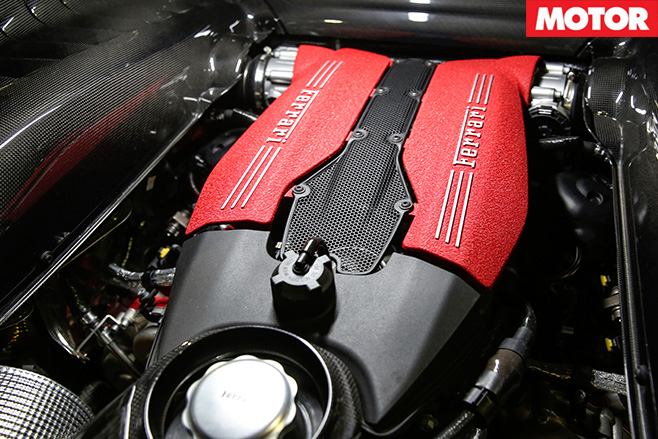
The engine stuttering at the 8200rpm limiter signals the need for another gear; a pull of the paddle is answered instantly, yet another shift is required almost immediately as second is gone in a heartbeat. Third reveals the devastating effectiveness of Ferrari’s variable torque management strategy as the acceleration feels to increase in ferocity.
Nervous laughter fills the cabin – there’s no other appropriate response. In seconds objective journalist has been replaced by giggling schoolchild, dumbstruck by an unholy force. While familiar with Ferrari’s variable torque trickery from the California T, the 488 turns it up way past 11.
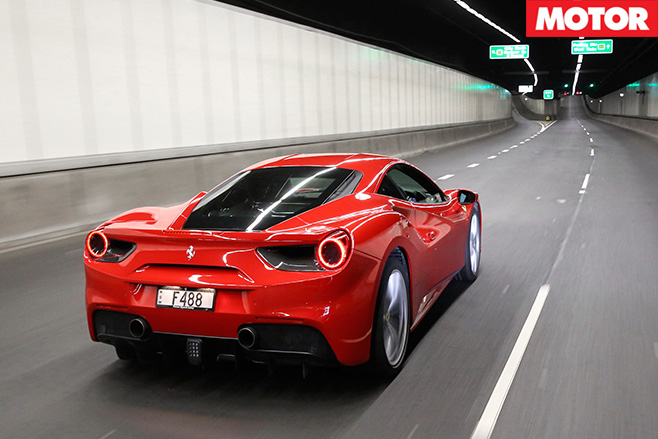
The road changes, wide-open sweepers giving way to narrow, bumpy switchbacks and hairpins with intermittent damp patches; perfect terrain for a Subaru WRX STI, a stern test for a 660hp rear-drive supercar. The 488’s outrageous thrust is now a problem; there’s too much of it.
Not for the car, but for my brain. Corners arrive so quickly that braking becomes rushed and clumsy and gears come and go in a blur. Traction seems strong but there’s no time to see if ESP intervention or mechanical grip is keeping things under control.
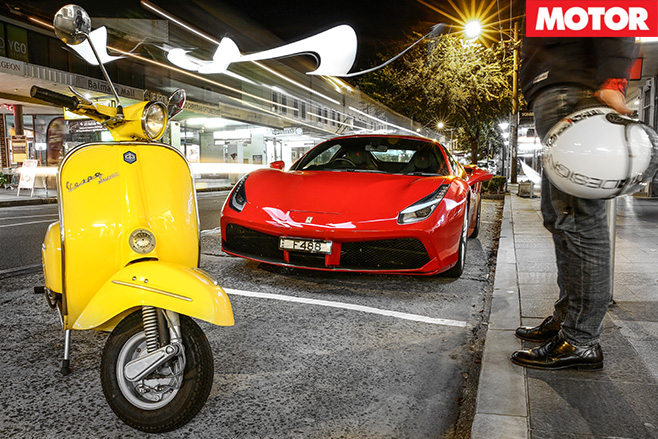
More than a little bamboozled, I continue and almost immediately I meet a series of well-sighted, medium-speed sweepers, punctuated by short straights, and a surface so smooth it’s like it’s been injected with Botox.
This feels like more appropriate territory for an Italian supercar. The acceleration is still shock-and-awe in its intensity, but the wider road and faster corners make it slightly easier to process.
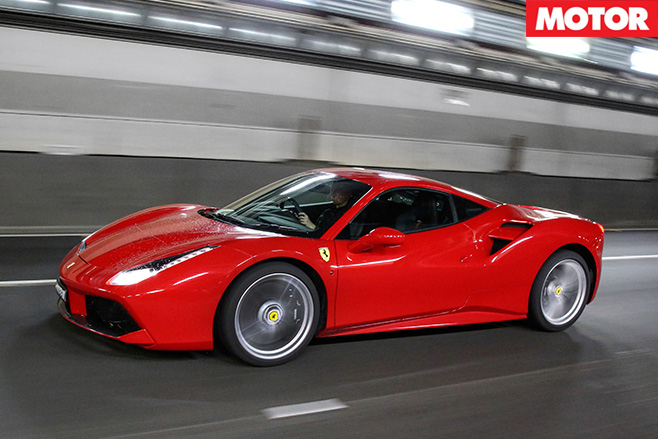
With 334kW/tonne, the 488 was always going to be fast, but the challenge with any turbocharged engine is response and noise. Ferrari has gone to great lengths to eradicate any lag, using twin-scroll ball-bearing turbochargers with titanium-alloy compressor wheels and three-piece, equal-length exhaust manifolds. The result is zero delay, or as near as makes no difference.
Ferrari claims response time in third gear at 2000rpm is a mere 0.1sec slower than the naturally-aspirated Speciale, and it has the graphs to prove it. As for the noise, well, to these ears it’s better than the 458’s. It’s loud, properly loud, still with that unique flat-plane V8 blare, but smoother and overlaid with the whine and inhalation of those clever turbos.

Now in its second-generation, SSC manages the stability control, electronic differential and active suspension and has the ability to soften each individual damper as the limit approaches to increase grip but also smooth the transition to slip.
It works brilliantly, allowing the driver to probe the 488’s limits with much greater confidence and thoroughly explore one of the best chassis around.

It wears regular Michelin Pilot Super Sports (245/35 front; 305/30 rear) rather than the more focused Cup 2s of the Speciale and they allow you to nudge in and out of understeer and oversteer, thanks in no small part to SSC.
The steering remains hydraulically-assisted and is very fast with just 1.9 turns lock-to-lock, but without any hint of off-centre nervousness. It is slightly affected by bumps and cambers, but that seems a small price to pay to be able to feel the texture of the road.

In pictures the 488 looks almost a little plain, particularly its gaping mouth, but as clichéd as it sounds, it looks much better in the metal, with serious supercar presence.
That beautiful shape is largely dictated by aerodynamics. The twin pillars in the nose split the airflow, directing some to the radiators and channelling the rest to the flat underbody.
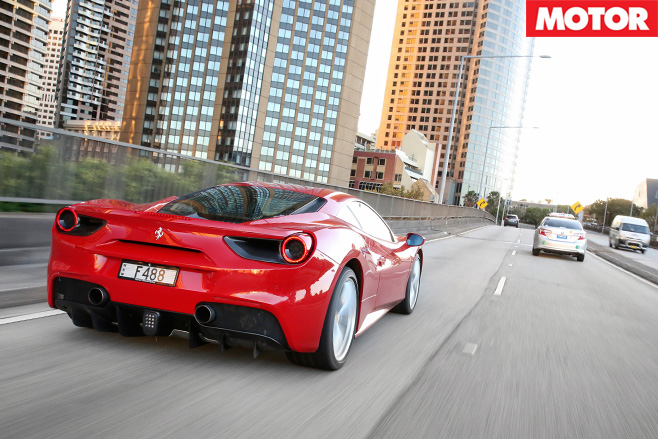
Like an early-80s F1 car, the 488 generates a lot of its downforce – 325kg at 250km/h – from its underbody, the rear diffuser housing electronically-controlled flaps that open to a maximum of 17 degrees to reduce drag.
From behind the wheel, the only hint of this aero trickery is a small ‘DRS’ symbol on the left-hand digital display. And that’s possibly the 488’s greatest achievement – it’s a fiendishly complex car, yet feels utterly transparent to drive.

Carrying an extra 80kg and with 1000rpm lopped off the redline, the 488 is probably not as visceral as the ultimate incarnation of its predecessor, but it counters by deploying its talents with greater driver comfort – it has carpet, for a start – and a hefty helping of extra performance. The handling makes the car feel like it’s an extension of your body, but it’s the acceleration that leaves the biggest impression.
I’ve never really been a ‘power guy’, but I’m now hopelessly addicted to the rush. And whenever doubt creeps in I might be overstating it, one more full-throttle blast is all it takes to dispel those concerns.
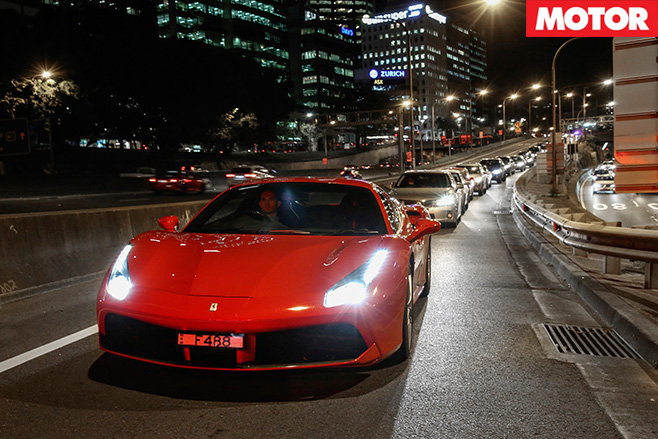
Potential improvements are few, though the most obvious – though likely specific to this car – would be to fix the rattling passenger seat and the buzz in the dash that began as a mild irritation but is rapidly approaching fingers-down-a-blackboard 400km later.
More general suggestions would be to move the shift paddles to the wheel and lose the keyhole in the driver’s door, it’s an unsightly blemish on that scarlet skin, and unnecessary now Ferrari has switched to keyless entry/start.

It’s a benchmark performance car and to answer the original question: what does acceleration like this feel like? Well, like much of what the 488 does, it’s simply phenomenal.
5 OUT OF 5 STARS
SPECS body 2-door, 2-seat coupe drive rear-wheel engine 3902cc V8, DOHC, 32v, twin-turbo bore/stroke 86.5 x 83.0mm compression 9.4:1 power 492kW @ 8000rpm torque 760Nm @ 3000rpm (seventh gear) power/weight 34kW/tonne transmission 7-speed dual-clutch weight 1475kg suspension (f) double A-arms, adaptive dampers, anti-roll bar suspension (r) multi-links, adaptive dampers, anti-roll bar L/W/h 4568/1952/1213mm wheelbase 2650mm tracks 1679/1647mm (f/r) steering hydraulically-assisted rack-and-pinion brakeS (F) 398mm ventilated discs, 6-piston calipers brakes (R) 380mm ventilated discs, 6-piston calipers wheels 20.0 x 9.0-inch, 20.0 x 11.0-inch (f/r) TYRE SIZES 245/35 ZR20 (f); 305/30 ZR20(r) TYRE Michelin Pilot Super Sport price as tested $593,910 PROS Unbelievable performance; useability; looks CONS Build quality niggles; fixed paddles; wait list
Dial a drift

In Wet mode it’s an utter pussycat and even in Sport the electronics are working overtime to keep you safe. Race is essentially the default mode, though CT Off activates Side Slip Control and will make you feel like a much better driver than you are.
If you happen to actually be that good, however, or are just very brave, then ESC Off will leave just your right foot in charge of controlling those 492kW.


